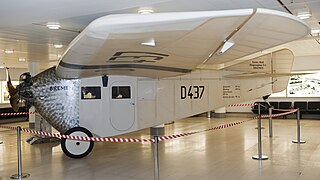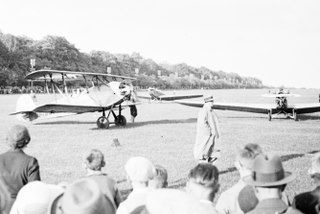
The Focke-Wulf Fw 190 Würger is a German single-seat, single-engine fighter aircraft designed by Kurt Tank at Focke-Wulf in the late 1930s and widely used during World War II. Along with its well-known counterpart, the Messerschmitt Bf 109, the Fw 190 became the backbone of the Jagdwaffe of the Luftwaffe. The twin-row BMW 801 radial engine that powered most operational versions enabled the Fw 190 to lift larger loads than the Bf 109, allowing its use as a day fighter, fighter-bomber, ground-attack aircraft and to a lesser degree, night fighter.

The Focke-Wulf Fw 61 is often considered the first practical, functional helicopter, first flown in 1936. It was also known as the Fa 61, as Focke began a new company—Focke-Achgelis—in 1937.

The Bramo 323 Fafnir is a nine-cylinder radial aircraft engine of the World War II era. Based heavily on Siemens/Bramo's earlier experience producing the Bristol Jupiter under license, the Bramo 323 saw limited use.

The Argus As 10 was a German-designed and built, air-cooled 90° cylinder bank-angle inverted V8 "low power" aircraft engine, used mainly in training aircraft such as the Arado Ar 66 and Focke-Wulf Fw 56 Stösser and other small short-range reconnaissance and communications aircraft like the Fieseler Fi 156 Storch during, and shortly after World War II. It was first built in 1928.

The Heinkel He 72 Kadett ("Cadet") was a German single-engine biplane trainer of the 1930s.

The Bücker Bü 133 Jungmeister was an advanced trainer of the Luftwaffe in the 1930s. It was a single-engine, single-seat biplane of wood and tubular steel construction and covered in fabric.

The Siemens-Halske Sh 14 was a seven-cylinder air-cooled radial engine for aircraft produced in Germany in the 1920s and 1930s. First run in 1928, it was rated at 93 kW (125 hp).

The Arado 95 was a single-engine reconnaissance and patrol biplane designed and built by the German firm Arado in the late 1930s. Ordered by Chile and Turkey, a number were taken over by the Kriegsmarine when World War II started.

The Arado Ar 76 was a German aircraft of the 1930s, designed as a light fighter with a secondary role as an advanced trainer in mind.

The Focke-Wulf A.16 was a German three/four passenger light transport monoplane designed by Heinrich Focke and Georg Wulf and was the first design built by the newly formed Focke-Wulf company.
The DAR-9 Siniger, was a trainer produced in Bulgaria during World War II.

The Focke-Wulf S 2 was a trainer aircraft built in Germany in the late 1920s. It was a conventional parasol-wing monoplane with fixed tailskid undercarriage. The pilot and instructor sat side by side in an open cockpit. Only a single example was built.

The Focke-Wulf S 24 Kiebitz was a sport aircraft built in Germany in the later 1920s. It was a single-bay biplane of conventional design with equal-span, unstaggered wings, braced with N-type interplane struts. The pilot and a single passenger sat in tandem open cockpits, and it was fitted with a fixed tailskid undercarriage. The wings could be folded for transportation or storage, and the aircraft was designed to be towed by a car.
The Siemens-Halske Sh 22 was a nine-cylinder aircraft radial engine manufactured by Siemens & Halske in Germany in the 1930s. Following the reorganization of its manufacturer and change in military nomenclature, the engine became known as the Bramo 322.

The Bayerische Flugzeugwerke M 18, was an airliner, produced in Germany in the late 1920s.

The BFW M.21 was a single-engined biplane trainer designed by Willy Messerschmitt for the German Ministry of Transport. It was one of only two biplanes Messerschmitt designed, neither reaching production.
The BFW M.22 was a twin-engined medium bomber, designed by Willy Messerschmitt for the German Ministry of Transport. It was one of only two biplanes Messerschmitt designed, both unsuccessful.

The Focke-Wulf Fw 62 was a reconnaissance floatplane, designed and built by Focke-Wulf for use by Nazi Germany's Kriegsmarine. Only four were built.

The Dietrich DP.II Bussard was a 1920s German two-seat training biplane designed by Richard Dietrich and built by the Dietrich-Gobiet Flugzeugwerke as Kassel.
The Arado Ar 69 was a two-seat German beginner's school and sport biplane with an open cockpit, developed in 1933 by Arado Flugzeugwerke.



















